|
The
Mothers' Union Banner and the Harris Family
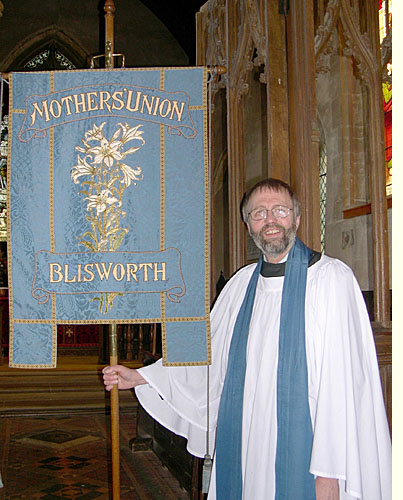 The inset picture was taken in 2006 and shows Derek Harris holding the
Mothers' Union banner in Blisworth Church. He had visited Blisworth for the Bicentenary celebrations of the opening of the Grand Union Canal and he had noticed the rather worn state of the banner. His account follows,
The inset picture was taken in 2006 and shows Derek Harris holding the
Mothers' Union banner in Blisworth Church. He had visited Blisworth for the Bicentenary celebrations of the opening of the Grand Union Canal and he had noticed the rather worn state of the banner. His account follows,
"Since my visits to Blisworth as
a small child, I have been fascinated by the history and culture of the
canals*. In 2005, I attended the tunnel anniversary celebrations. I had not been in St. John's Church for about forty years, and was amazed to see the Banner still standing in the corner of the sanctuary! Knowing its history, it was quite an emotional moment.
"The banner and the stand were not in the best state of repair. On my drive back to Peterborough, I formulated the idea that the family could have it restored, and I, with my C of E lay reader's hat on, could rededicate it to my grandparents' memory. My father and Uncle Eric had both passed away, but I contacted Uncle Frank and my cousin, Alan Harris (Eric's son) who thought this a great idea. I arranged with the
Blisworth PCC to collect the banner and bring it back
to Peterborough. A local blacksmith did a superb job on the stand. The Royal School of Needlework at Hampton Court Palace restored the fabric beautifully and, on 19 Nov 2006, I duly rededicated it."
* Derek Harris also offers
entertainment shows that are based on the Canals by way of a contrast
from his lay readers role; see his
website.
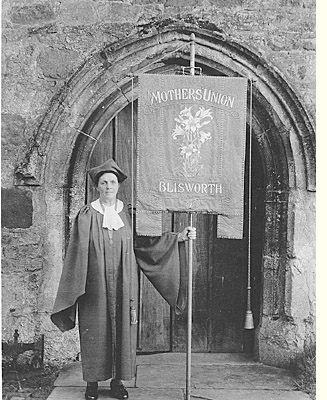 The history of the banner alluded to by Derek is this. His grandparents, Florence and William Harris, had three sons, Rupert, Eric and Frank.
All three enrolled as soldiers and departed to various places through
WWII and afterwards. And they all came back. The mother, Florence, was so overwhelmed with gratitude that she arranged to have made a banner for the Blisworth branch of the
Mothers' Union. The inset picture here shows Florence in 1947 in her Church Choir uniform with the new banner at the
Church south door.
There is a picture also of three of the members of the Mothers' Union holding
the banner in around 1947.
The history of the banner alluded to by Derek is this. His grandparents, Florence and William Harris, had three sons, Rupert, Eric and Frank.
All three enrolled as soldiers and departed to various places through
WWII and afterwards. And they all came back. The mother, Florence, was so overwhelmed with gratitude that she arranged to have made a banner for the Blisworth branch of the
Mothers' Union. The inset picture here shows Florence in 1947 in her Church Choir uniform with the new banner at the
Church south door.
There is a picture also of three of the members of the Mothers' Union holding
the banner in around 1947.
The subject of the banner was recently (8 Aug 2011) brought to my attention first by Frank and a day
later by his nephew Derek.
Frank subsequently paid me a visit for a chat and to allow me to scan
some more pictures. The story of the Harris family in Blisworth is one that
is typical of the later Victorian and early 20th century era and a little is retold below.
William, born Nov 26, 1888, married Florence Kate Vinter of Blisworth and lived in the flat within the building that was the village school before 1913. At one time William declared his profession to be a gardener. That was when he joined the Oddfellows in Blisworth and one wonders whether he worked for the florist Alfred Alexander (Walter Alexanderís father). He was a member of the Blisworth Flower Show Committee in the 1920s
and worked on Griffith's farm (Cliff Hill) for a while until beginning a
50 year career as platelayer working for the LMS railway company.
The family managed to persuade him to retire at 65 but not without the complaint
that his pension would have been the better by 2/-d if he had stayed on till 70! They moved to one of the Mount Pleasant cottages in around
1931 where they remained until both passed away in the 1970s.
House numberings were re-arranged and made to include everywhere in
1952, so this cottage became No.15 Courteenhall Road and No15 is
used as shorthand with some of the pictures below.
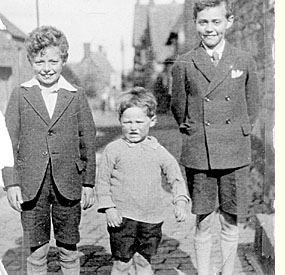 There were three sons, Rupert, Eric and Frank born in 1917, 1920 and 1925
respectively (see inset picture taken in c1928 outside the 'old school
house'), and they all followed their mother into the Church choir and
then their father into the Oddfellows Society at the age of sixteen in the years running up to the WWII.
At that age they declared occupations, respectively, as a grocer's
assistant (with the Youngs?),
an errand boy (with Roland Hill ironmongers, Bridge Street) and a bakehouse worker (with Messrs. Sturgess),
all being clearly motivated to help the home economics stretch further. Frank at Sturgessís started at 13 while still at school, cleaning and greasing
baking tins, and gained full-time employment at 14 on leaving school until he joined the army.
There were three sons, Rupert, Eric and Frank born in 1917, 1920 and 1925
respectively (see inset picture taken in c1928 outside the 'old school
house'), and they all followed their mother into the Church choir and
then their father into the Oddfellows Society at the age of sixteen in the years running up to the WWII.
At that age they declared occupations, respectively, as a grocer's
assistant (with the Youngs?),
an errand boy (with Roland Hill ironmongers, Bridge Street) and a bakehouse worker (with Messrs. Sturgess),
all being clearly motivated to help the home economics stretch further. Frank at Sturgessís started at 13 while still at school, cleaning and greasing
baking tins, and gained full-time employment at 14 on leaving school until he joined the army.
On the outbreak of war, Rupert joined as a Sapper in the Royal Engineers. His service took him to Italy, South Africa and Persia (Iran). Eric joined the RAF and served
as 'ground staff/engineering' in Egypt and Libya.
Frank, being a few years the youngest, joined the home-guard in 1941 and
then joined the Grenadier Guards and went to France in the August after
D-Day. Rising to the rank of sergeant, he saw service in the 2nd
Armoured Battalion in France, Belgium, Holland and Germany, grouped
throughout with the 1st Battalion Motorised Infantry (ie. tanks) in
which Ron French served. In fact Frank
met up with Ron French a few times when at rest. Frank continued
in the Guards with a later stint in Malaya in
1949 and remained in the army until 1955.
Frank then began a 30 year career in the Northamptonshire police. After the war Rupert worked
for the LMS railway company, to begin with as a porter, and Eric worked for a leather importing company in Dunster Street, Northampton.
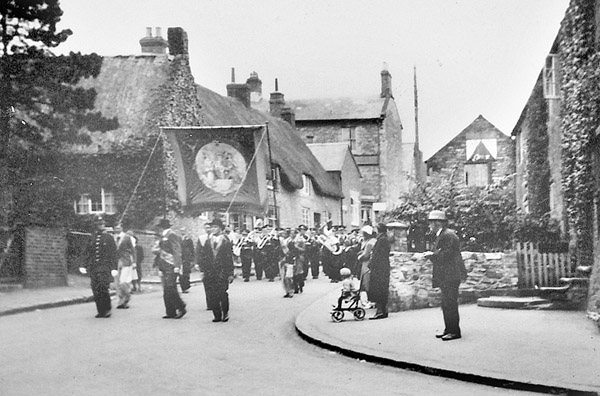
Frank kindly brought this picture taken of the
Feast Day procession for 1939. It shows the nicely
resurfaced roads of 1937 and the "bacon factory" cottages with
thatch rather than tiled roof. There
is a gent who reminds us of Whitty Whitlock,
with well shined shoes,
watching from the pavement.
Frank remembers Whitty chiming the three bells, 'ding - dang - dong',
in a habitual eccentric solo act
using two hands and a loop for his foot. It was as a call to
service, an alternative to ringing just the
treble Sanctus Bell for five minutes. Well after Whitty's time,
Mason Masterman recalls in the 1970s
Mr. Sturgess the baker doing this on bells 2, 3 and 4. Is this just a
Blisworth quirk? Naturally the
trick worked in using clapper-strikes on just
one side of the bells.
There follows some of the family pictures offered by Frank
and Derek.
|
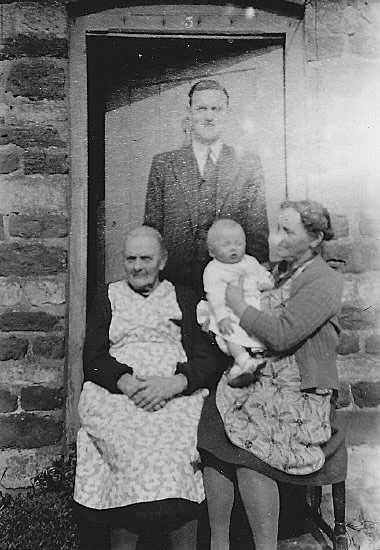
Four generations: Baby Derek, sitting on
Florence Kate's lap,
Florence's mother Rebecca Vinter seated with Rupert (Derek's father)
standing at the door of No15, taken 1951.
|
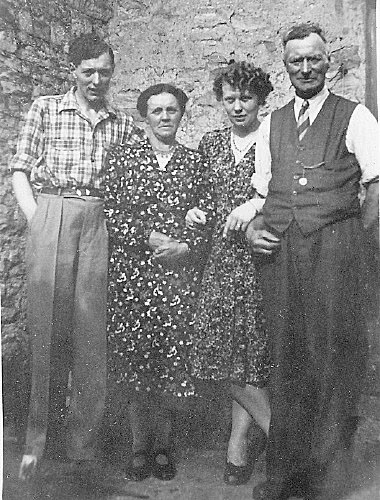
Eric with his wife Evelyn, and mother and father -
Florence and
William. Date uncertain.
|
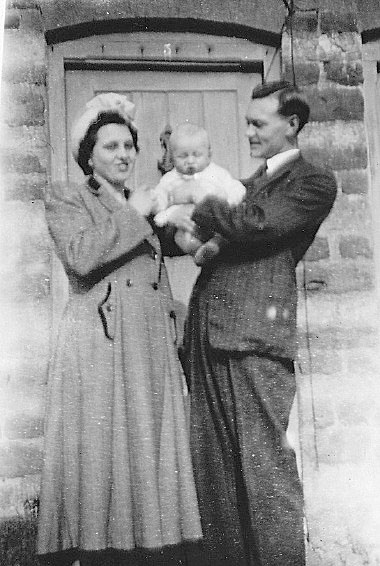
Baby Derek with mother and father, Doris and
Rupert, 1951 outside No15 (then numbered 3)
|
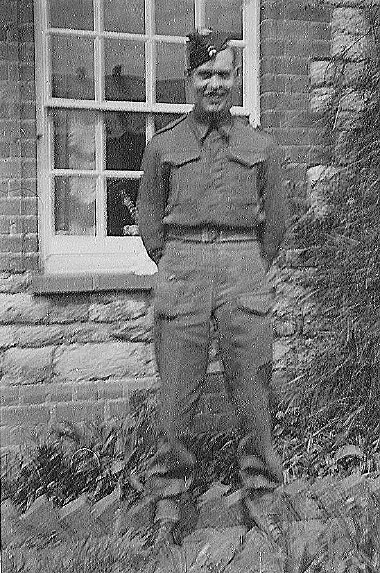
Rupert as Sapper in the Royal Engineers. Taken
probably in Towcester c 1941.
|
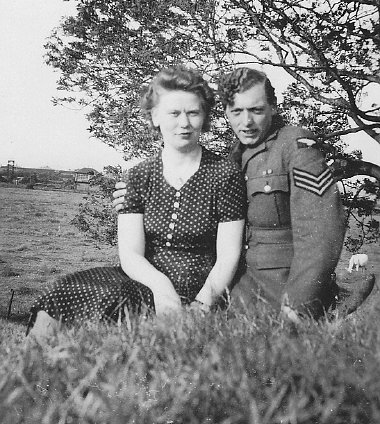
Eric with wife Evelyn, still in the RAF, c 1953
|
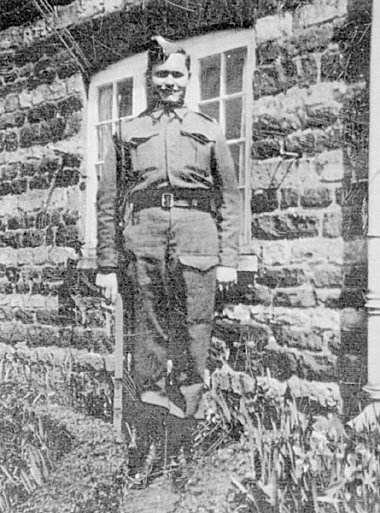
Frank at 16 or 17 outside No15. Wearing
home-guard uniform and standard issue Lee Enfield 303.
|
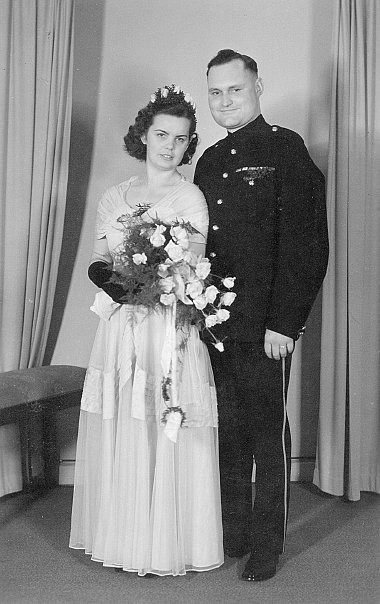
Frank and his bride, 1952
They are still together
|
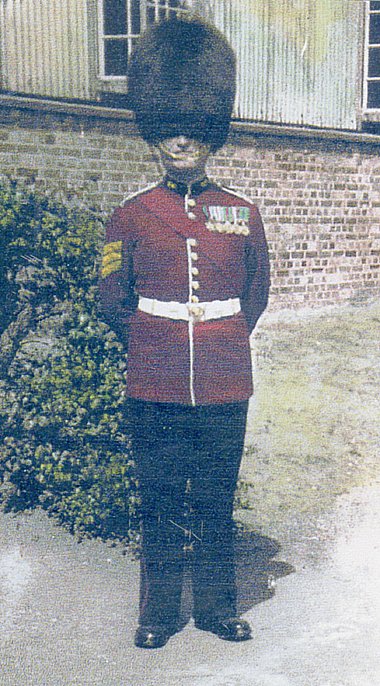
Frank in Grenadier Guard finery made to measure in
Tooley Street SE1 for the Queen's Company at her Coronation in 1953.
|
 This picture shows the carved oaken shields that
are attached to the base for
the banner. They show the badges for the three regiments that the father and
the sons joined. The
carvings were the work in 1947 of Mr. J. Reynolds of Northampton, who has
examples of his work (in wood or stone) in many churches in Northants.
This picture shows the carved oaken shields that
are attached to the base for
the banner. They show the badges for the three regiments that the father and
the sons joined. The
carvings were the work in 1947 of Mr. J. Reynolds of Northampton, who has
examples of his work (in wood or stone) in many churches in Northants.
From left to right: 'IHS' symbolic
Greek abbrev. of Jesus, RAF badge (Eric), Royal Engineers badge
(Rupert, also father William in WWI)
and the Grenadier Guards badge (Frank).
|








 This picture shows the carved oaken shields that
are attached to the base for
the banner. They show the badges for the three regiments that the father and
the sons joined. The
carvings were the work in 1947 of Mr. J. Reynolds of Northampton, who has
examples of his work (in wood or stone) in many churches in Northants.
This picture shows the carved oaken shields that
are attached to the base for
the banner. They show the badges for the three regiments that the father and
the sons joined. The
carvings were the work in 1947 of Mr. J. Reynolds of Northampton, who has
examples of his work (in wood or stone) in many churches in Northants.
 The inset picture was taken in 2006 and shows Derek Harris holding the
Mothers' Union banner in Blisworth Church. He had visited Blisworth for the Bicentenary celebrations of the opening of the Grand Union Canal and he had noticed the rather worn state of the banner. His account follows,
The inset picture was taken in 2006 and shows Derek Harris holding the
Mothers' Union banner in Blisworth Church. He had visited Blisworth for the Bicentenary celebrations of the opening of the Grand Union Canal and he had noticed the rather worn state of the banner. His account follows, The history of the banner alluded to by Derek is this. His grandparents, Florence and William Harris, had three sons, Rupert, Eric and Frank.
All three enrolled as soldiers and departed to various places through
WWII and afterwards. And they all came back. The mother, Florence, was so overwhelmed with gratitude that she arranged to have made a banner for the Blisworth branch of the
Mothers' Union. The inset picture here shows Florence in 1947 in her Church Choir uniform with the new banner at the
Church south door.
There is a picture also of three of the members of the Mothers' Union
The history of the banner alluded to by Derek is this. His grandparents, Florence and William Harris, had three sons, Rupert, Eric and Frank.
All three enrolled as soldiers and departed to various places through
WWII and afterwards. And they all came back. The mother, Florence, was so overwhelmed with gratitude that she arranged to have made a banner for the Blisworth branch of the
Mothers' Union. The inset picture here shows Florence in 1947 in her Church Choir uniform with the new banner at the
Church south door.
There is a picture also of three of the members of the Mothers' Union  There were three sons, Rupert, Eric and Frank born in 1917, 1920 and 1925
respectively (see inset picture taken in c1928 outside the 'old school
house'), and they all followed their mother into the Church choir and
then their father into the Oddfellows Society at the age of sixteen in the years running up to the WWII.
At that age they declared occupations, respectively, as a grocer's
assistant (with the Youngs?),
an errand boy (with Roland Hill ironmongers, Bridge Street) and a bakehouse worker (with Messrs. Sturgess),
all being clearly motivated to help the home economics stretch further. Frank at Sturgessís started at 13 while still at school, cleaning and greasing
baking tins, and gained full-time employment at 14 on leaving school until he joined the army.
There were three sons, Rupert, Eric and Frank born in 1917, 1920 and 1925
respectively (see inset picture taken in c1928 outside the 'old school
house'), and they all followed their mother into the Church choir and
then their father into the Oddfellows Society at the age of sixteen in the years running up to the WWII.
At that age they declared occupations, respectively, as a grocer's
assistant (with the Youngs?),
an errand boy (with Roland Hill ironmongers, Bridge Street) and a bakehouse worker (with Messrs. Sturgess),
all being clearly motivated to help the home economics stretch further. Frank at Sturgessís started at 13 while still at school, cleaning and greasing
baking tins, and gained full-time employment at 14 on leaving school until he joined the army.